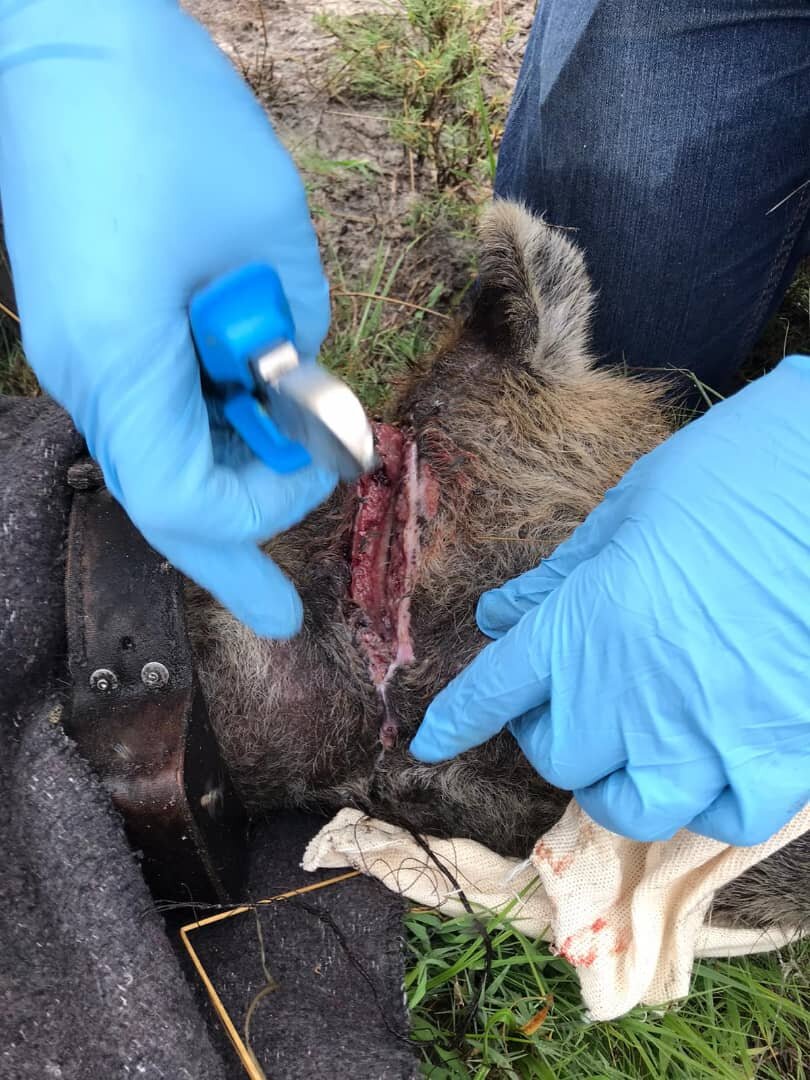Liuwa’s North Clan Hyenas Benefit From Collaborative Conservation Work
By: Sandra Martens, ZCP Liuwa Project Senior Ecologist
The morning promised to be a normal field day for the ZCP Liuwa team, with several ecologists fanning out to different areas of our study area in the Greater Liuwa Ecosystem to locate carnivores in order to collect data for our long-term conservation science programme. A seemingly easy and calm morning, however, very quickly turned into a much busier one when field researcher Dean Banda, a Conservation Biologist trainee and team member for almost 3 years now, had an unsettling discovery in North clan.
Liuwa Project Field Ecologists from left to right, Peter Musenge, Dean Banda and Bridget Mayani prepare to head out into the field. Photo Credit: Daan Smit/ZCP Liuwa Project Manager
North clan is one of the 11 clans closely monitored and studied by ZCP in the Greater Liuwa as part of our long-term collaborative carnivore conservation work with the Department of National Parks and Wildlife (DNPW), and African Parks Network (AP). The clan has also has been studied since the start of the ZCP project in Liuwa in 2010, when the clan’s territory was situated North of the ZCP basecamp, Matiamanene. Although over the years other clans have pushed them into the Eastern plains and though they are now, in fact, East of camp, they have never managed to shake the North clan title! The number of North clan hyenas has decreased over the years since they were pushed into more challenging territory by other clans, leaving them with less prey in the dry season and more human conflict. Their territory is lined on both the Northern and Southern boundary by villages, resulting in much human activity and increased threat of wire-snare poaching. The North clan hyenas appear to fall victim to those wire-snares disproportionately often.
In order to better follow and monitor clans—and protect them from snares—one to three females per clan are fitted with a VHF (or satellite) tracking collar. In North clan, three females are each fitted with a such a collar. These collars help us to track, monitor and follow individuals and hereby collect data on the demography, dynamics, and ecology, of not only the individual wearing the collar, but even more so of the entire clan. This is because hyenas are gregarious carnivores that are often found together in small or larger groups when hunting at night and resting during daytime. These groups generally include one to several females, their offspring and immigrant males. One of the collared females is LHY-471, affectionately called Bruno, who has been collared since April 2016 and has, through her collar, allowed us to get a lot of information about North clan’s territory, demography, reproduction rates, hunting behaviour and the threats that the clan faces. Bruno herself has proven to be quite the rockstar, successfully raising 4 cubs in 3 litters so far!
On that particular morning of the 11th of January, Dean found Bruno and several other hyenas resting in a pan by tracking her collar, and did a routine health inspection with binoculars (to check for snares, injuries or any other abnormalities). When checking Bruno, he immediately saw the wire snare that was deeply cutting into her neck, causing a deep and life-threatening injury to the throat.
A close-up of the deeply embedded snare around Bruno’s neck. Photo Credit: Daan Smit
Dean informed team members in camp through the park radio-system and while he stayed with Bruno, the matter was communicated to the team in Kafue, informing our Kafue-based vet Dr. Kambwiri Banda. Whilst the Liuwa team started preparing for de-snare action, Dr. Banda started his 9-hour journey to the plains of Liuwa.
By the end of the afternoon, big thunderstorms were rolling in from all sides, but the Liuwa team was ready and Dr. Banda and team members from our partners African Parks and the Department of National Parks and Wildlife had arrived. Despite the heavy rains making our mission even harder, we had only one plan: to cut that nasty snare around Bruno’s neck and save her life. The darting went well and only took one very accurate and well-coordinated shot by Dr. Banda. Soon after, Bruno was fast asleep and the team moved in. When an animal is immobilized like that, close monitoring of vital functions is vital and so each team-member has a task. While Dr. Banda attends to the wound, assisted by one person, other people monitor breathing, temperature, and provide overall vet-assistance. Everything went well. Dr. Banda removed the deadly snare wire and cleaned the wound. Soon after the reversal drugs were administered that woke her up, slowly and a little groggy, but snare-free!
Liuwa’s team members Dean Banda, Bridget Mayani, Sandra Martens, Kings Chimungu (Field Ecologist), and Peter Musenge all have their part in assisting Dr. Kambwiri Banda (ZCP Wildlife Veterinarian) with de-snaring Bruno – It is an all hands-on effort! Photo Credit: Tineke Floor/African Parks’ Fundraising Director Europe and Senior Management Netherlands
After she was fully recovered, we returned to camp and planned to check on her the next day as per procedure. But we were expecting the best as Bruno woke up so well and moved freely. And we were right. And a few weeks after the de-snaring mission, Bruno was seen again, by our very own Dean. She was in good health, nice and fat from the kill she had eaten that night and rocked a barely visible snare scar!
Bruno was the 7th Liuwa hyena in 3 years’ time to be successfully desnared by ZCP, DNPW and AP. Hopefully she will continue to live strong, in good health and with many cubs to strengthen the North clan for many years to come.
Snare successfully removed and wound cleaned. Photo Credit: Daan Smit




